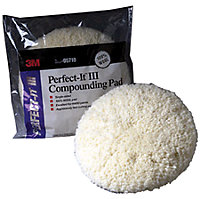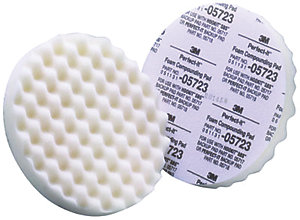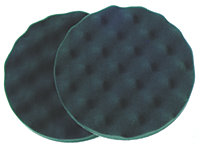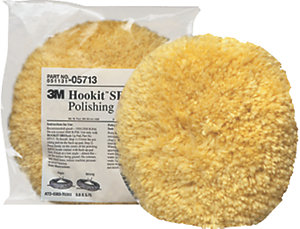Choosing the Right Buffing Pad
The vast array of available buffing pads can be overwhelming to even the most savvy professional. Choosing the right buffing pad is critical to both completing your job efficiently and achieving the best result. To help you choose the right buffing pad, the following describes the main types of buffing pads and how they should be used.
Why Should I Use a Buffing Pad?

Buffing pads are used to apply liquid abrasive compounds and polishes to a fiberglass, painted, or metal surface to give them that ultimate shine. They are used in place of doing the work by hand – a huge time savings for today's busy boaters.
Buffing pads should be used after the surface has been prepped for final compounding and/or waxing – which means removing any big scuffs or scratches by sequentially sanding with finer and finer abrasive discs or papers – typically down to 1200 grit, or finer. Once you have reached this point, you are ready to use your buffing pad.
Compounding vs. Polishing
Although the term “buffing” is often loosely used in reference to the entire process,“buffing pads” can be broadly divided into two types – compounding and polishing. Each of these types can be of either fiber or foam construction.
Compounding Pads

You can think of compounding as sanding with super fine sandpaper - finer than what you would typically find in a store. Compounding pads are used with liquid rubbing compounds that contain fine abrasive particles. Although the abrasive in the compound does most of the work, the structure of the pad itself (whether fiber or foam) also performs some of the abrasive work.
Compounding is usually described as refining (wearing down) very tiny scratches left by 1200 grit (or finer) abrasives. So, sanding is recommended to that level, unless you are simply refurbishing an oxidized finish that is otherwise in good shape, in which case sanding is probably not needed.
Foam compounding pads are constructed of stiffer, coarser foams than those used for polishing. Foam compounding pads can generate a lot of heat – so be very careful not to let your pad get too hot. Foam is typically used on painted surfaces (like cars and painted boats) that can tolerate the higher temperatures.
Wool compounding pads are preferred for use on gel-coated surfaces (like boats), since they don't generate high surface temperatures that can damage a gelcoat surface. Wool pads also work well on painted surfaces.
Polishing Pads

Polishing pads are used with liquid polishes and glazes (super-fine polishes) containing even finer abrasives than those in compounds, and continue the scratch refining process to the point where the scratches are no longer visible and the surface has a glossy shine.
Polishing pads are constructed of softer foam or softer, thinner fibers that are typically acrylic, or acrylic/wool blends. The yarns usually have less “twist” than those used in compounding pads, making them softer and less aggressive.
Materials and Structure
 As a broad group, “buffing pads” are typically made of wool, acrylic fibers, or foam.
As a broad group, “buffing pads” are typically made of wool, acrylic fibers, or foam.
- Pure wool pads tend to be more abrasive, and are most often used for compounding. Wool is a little more challenging to use for a beginner since too much pressure can cut the surface too quickly or cause swirl marks if you're not careful. But it doesn't get as hot as foam, so that can be a plus if you are working on gelcoat.
- Acrylic/wool blends have finer, softer fibers, and are usually used for polishing.
- Foam pads come in different degrees of aggressiveness. 3M's white foam pads are suitable for compounding, their black pads for polishing, and their light blue pads for ultra-fine polishing or applying wax. Foam pads will often have a convoluted face designed to better hold compounds and polishes so as to reduce the slinging of the liquid off the pad during use. Foam pads tend to be a little more forgiving for beginners, but can get very hot – so use with caution when working with gelcoat.
Fisheries Supply carries a wide range of boat buffing products from 3M, Meguiars, Mirka and more. We hope you've found this Navigator useful, but if you have additional questions one which buffing pad is right for your specific job – please don't hesitate to give our experts a call at (800) 426-6930.
To read more on how to use compounds, polishes and glazes – check out A Guide to Restoring Gelcoat.